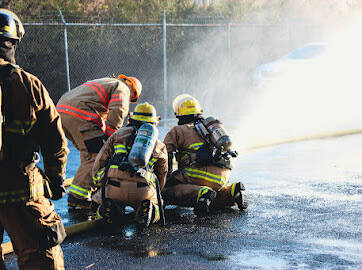As the world prepares to see what fresh new horrors yet undreamt of by man 2023 holds for us all, dozens of volunteer firefighters across the county are getting ready to go through the fire or emergency medical technician academies held by local agencies to advance their craft.
The academies, held separately, help bring volunteers up to a set standard in either the fire or medical side of operations, ensuring that the many volunteer or mixed volunteer departments across Grays Harbor have trained volunteers to assist in saving lives.
“I think that the public really needs to be aware that becoming an EMT is almost the most important aspect of being in the fire service,” said David Schrier, a firefighter/paramedic with the Aberdeen Fire Department and the senior instructor for the EMT course. “When someone calls 911 for a medical emergency or a traumatic injury, they can be assured that the people that’s coming to help them will have received the training they need to help them. Whether they’re paid or volunteer, it doesn’t matter. It’s imperative to have this class and continue to have this class to continue to serve the people of Grays Harbor.”
[Grays Harbor endures windy winter weather with elan]
The EMT course brings its 24 registered participants up to EMT standards — above emergency medical responders, but lower than paramedics — while the fire academy does the same for its students, training them and offering them the chance to test for their Firefighter 1 certification, said Darin VanderVeur, battalion chief of training for South Beach Regional Fire Authority and drillmaster for the fire academy.
“Recruit Academies have been around for a long time,” VanderVeur said in an email. “The information we teach itself gets reevaluated every few years to ensure we are teaching the newest up-to-date standards based off NFPA (National Fire Protection Agency) and best practices.”
SBRFA will host this year’s fire academy, while the Grays Harbor EMS Office hosts the EMT academy every year. It will be Schrier’s third time as the head instructor, and VanderVeur’s second. Both have also participated in many of their respective academies as one of the lower-level instructors who deliver much of the information to students.
“This year (2022) and next year (2023) we are blessed to receive the state funding for the Fire Academy classes,” VanderVeur said. “This is the Regional Direct Delivery Program that we were able to qualify for from the Washington state Fire Marshal’s Office. They pay for the instructors, student materials, testing and any other items needed to ensure the success of the Academy.”
Students in each academy will go through hundreds of hours of training, with classes scheduled on several weeknights every week and many Saturdays throughout the months-long courses. Restrictions on classes from COVID guidelines that saw the 2020 academies scuttled have been relaxed, leaving the weather as the largest threat, Schrier said.
“This year I have not had any restrictions in preparation,” Schrier said. “I think the biggest problem we have is snow. People aren’t able to make it to class.”
The courses combine classroom learning with practical application. EMTs will learn lifesaving techniques, safely extracting casualties from cars and buildings, medication, physiology and about the fire service in general, Schrier said.
“There are some medications EMTs are allowed to administer. We learn what to give them, when to give them, how to give them, when not to give them,” Schrier said. “We need to manage the airway. If somebody is not breathing, we learn to breathe for them.”
The fire academy will learn the art of fighting fire in a rigorous and scientific fashion, with SBRFA’s new training center the ideal and safe learning environment, VanderVeur said.
“It is the perfect place for all trainings pertaining to Firefighter 1. We can do all the classes and testing on site,” VanderVeur said. “We now have a burn lab which means we can do live fire training on site as well and not have to travel to North Bend Fire Training Academy. Part of the Firefighter 1 certification testing the cadets must have live fire and we can do it safely on site.”
With many volunteer departments across the county, making sure they have a good grounding of knowledge is critical, both for lifesaving and responding to fires, Schrier said.
“When someone calls 911 for a medical emergency, more times than not, they’re going to get an EMT,” Schrier said. “EMTs serve a really huge purpose in this county, really huge.”
It’s no less serious for the fire academy, VanderVeur said.
“On the volunteer side this is a great way to learn the basics and be able to pass this knowledge onto others in their respective departments,” VanderVeur said. “The saying we have is ‘fire doesn’t care if you’re a volunteer, part-time, career or other. It will kill you all just the same’.”
Contact reporter Michael S. Lockett at 757-621-1197 or mlockett@thedailyworld.com.



